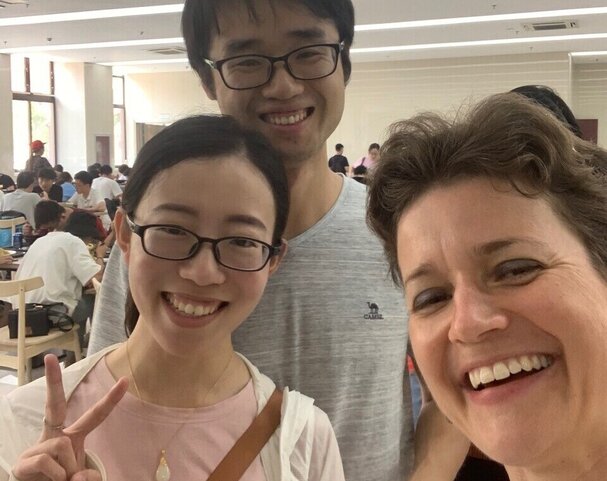
Teresa Valencak with students Xiaoyang Xu (xx) and Yuliang Huang.
Credit: Teresa Valencak
What I learned teaching in China during the COVID-19 pandemic
Globalized higher education requires fresh cross-cultural approaches.
13 July 2021

Teresa Valencak
Teresa Valencak with students Xiaoyang Xu (xx) and Yuliang Huang.
China was on my radar when, in 2018, I was looking for a new faculty position to progress my career. I was working as an associate professor at the University of Veterinary Medicine in Vienna; five years prior I had completed a two-year postdoc at the Chinese Academy of Sciences, Beijing. I knew the high value China places on science and research, its funding opportunities, its skilled students and its “get things done” attitude.
I came across a vacancy at Zhejiang University in the provincial capital, Hangzhou, located around 180 km west of Shanghai. My negotiations with the hiring board took place via email and phone messaging apps, and during a three-day stay at the university’s main Zijingang Campus, which in September 2019 became my official work place.

Teresa G. Valencak. Credit: Simon Callaghan
Zhejiang University is among the oldest in China (founded in 1897), and one of the leading universities in the country. Its seven campuses extend in all directions within Hangzhou. At the College of Animal Sciences, I was the first foreign faculty to be hired.
I quickly perceived significant differences in teaching in my experience of the “West” and China in modes of delivery, class size, skills and in the relationship between students and mentors. I found that teaching focused more on memorization than it did in Europe, and although students quickly picked up content via textbooks, they were less accustomed to group work or classroom discussions.
In my view, to be useful for foreigners teaching in China, internationally used course books and lesson plans need to take account of these differences.
In my experience, early morning classes struggle to attract students in a western university setting. But at Zhejiang University, lecture halls and teaching buildings were very busy well before 8am; students and faculty enjoyed a freshly cooked, warm breakfast at around 6am.
The formal relationship between students and faculty in the classroom did not extend to the campus cafeteria. It was part of the culture for lab groups to spend their lunch break together before returning to the desk or lab bench.
In class at Zhejiang University, teachers were distant intellectuals who delivered content but were not to be interrupted. Students were often timid about openly sharing their thoughts and questions in class or with teachers individually. Many were reluctant to interact with me, I think at least in part due to a lack of confidence in speaking English.
Pandemic effects
COVID-19 accelerated the use of online teaching tools across the globe. I witnessed first-hand how China, compared with the West, was very well prepared to take university classes into full online teaching in the first two weeks of February 2020.
Chinese academic institutions already used phone apps to communicate with students and share course content. In addition, hundreds of talented programmers from Zhejiang University swiftly worked to improve digital learning systems during the lockdowns, when the switch to online exams occurred.
With students confined to dormitories or parents’ homes for several months, I organized 11 virtual Zoom webinars for 100 undergraduate students in animal science in July and August 2020. All speakers were scientists from outside China as I sought to partly make up for the loss of opportunities to attend any international guest lectures and networking events in person due to pandemic travel restrictions.
The webinar series addressed not only research topics in the animal sciences, but also career planning and modern biomedical technology, functional molecular biology and sequencing.
The series aimed to provide students with a sense of normalcy through networking and training delivered by people talking to them directly, albeit online. I invited a diverse group of five female and six male speakers from Europe, the US, Australia and Japan. Students could interact using the chat function in Zoom or by sending their question to me via WeChat in Chinese or English.
The in-app translations worked amazingly well; it seemed as if there was no language barrier at all between the speakers and the students. The students were more confident communicating in writing and many asked for a recording of our webinar session. I feared a drop in “live” attendance until I realized they were actively using the recordings to practice their English and reflect on the content.
I returned to Austria in October 2020, wanting to be close to family and friends during the pandemic. By then, my earlier expectation that students would ask questions during lectures felt old-fashioned.
My previous European classroom experiences were more interactive, embracing problem-based learning approaches, but my Chinese students learned flexibly after the lecture more than during it. They used recorded material, looked up content both alone and via references provided with the course notes and formed their own take-home messages. I would receive interesting questions from them several days after a session.
Based on my experience at Zhejiang University, I would like to see more development in the West of a learning system in which input from both teachers and experts is used as a research-led teaching tool for subsequent teacher-student interactions, for example via texting and one-on-one online conversation. Seeing their faces and even fluently speaking their language need not be fundamental requirements.
Globalization in higher education demands a new internationally recognized teaching approach that caters better to cross-cultural contexts.
This article has been contributed by a member of the Nature Index community. See our pitching guidelines.
Teresa G. Valencak is adjunct associate professor at the College of animal science at Zhejiang University. Her research focuses on energy metabolism and aging in mammals. Email: teresavalencak@zju.edu.cn
